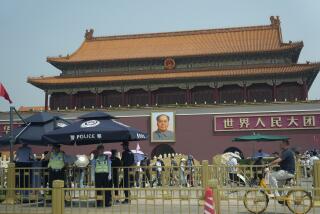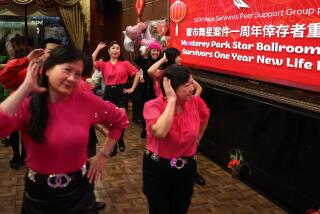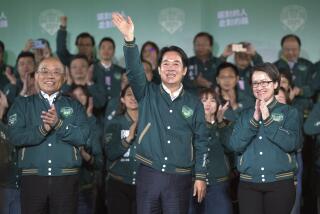Taiwanese Community Mourns a Dissident and Renews Debate
- Share via
A man burns himself to death in Taipei rather than surrender to police to face charges of sedition. News of his death rocks Chinese communities worldwide, and a martyr is born.
In the San Gabriel Valley, supporters of Nan-jung Cheng, a leader in the Taiwan independence movement, are still recovering from shock over his death April 7.
“I couldn’t sleep,” Walnut resident Joshua Su said of his reaction upon hearing the news. Su was one of more than 300 Cheng admirers, from Hacienda Heights to Irvine, who gathered in El Monte last weekend for a memorial service.
For some supporters, Cheng’s death has strengthened their own commitment to the establishment of a country not ruled by the present Kuomintang government or the People’s Republic of China. They maintain that only independence will guarantee residents democracy and freedom of speech.
‘Not the Solution’
For others, such as moderates who call for democratic freedoms but do not necessarily seek a different government, Cheng’s death is viewed as a senseless sacrifice. Even some members of Taiwan’s Democratic Progressive Party, a major opposition party that Cheng identified with closely, had reservations about his action.
“Burning himself to death is not the solution,” Shin-chieh Huang, head of the Democratic Progressive Party, told television reporters in Taiwan.
Huang’s comments, criticized by some fellow party members as inappropriate, highlighted the party’s internal frictions--frictions mirrored in Taiwanese communities here.
Just as in Taiwan, support for the independence movement in the San Gabriel Valley represents a minority viewpoint, said Charles Ho, a developer active in Alhambra’s Chinese community.
“I don’t think they are really accepted well,” Ho said. “A lot of people do not agree with independence.
“But it’s fair to say that everyone would like to see Taiwan be more democratic,” said Ho, a mainlander who spent his youth in Taiwan before moving to the United States. “His death only gives a small group of people some excuse for propaganda, that’s all,” Ho said.
Rowland Heights resident Yu-ping Hsia, a chemistry professor at Cal Poly Pomona, said he does not support the independence movement.
Respect His Spirit
“I respect (Cheng’s) spirit, but I don’t think his method is right,” Hsia said. “It’s abnormal.
“Taiwan independence, these two words I’m not in favor of,” said Hsia, who emphasized he is not a Kuomintang member. “I think Taiwan is part of China.”
The independence movement is not viewed favorably by the Kuomintang, People’s Republic of China or U.S. governments, all of which espouse a one-China policy. Under that policy, Taiwan is viewed as a province in China.
But while the United States in 1979 officially recognized the Communist government on the mainland, Kuomintang officials in Taiwan continue to view themselves as representing the legitimate government of China. The Kuomintang became the government in exile after communists took over mainland China in 1949. Hundreds of thousands of mainlanders fled to Taiwan to escape the communists.
The relationship between mainlanders, who fled after 1949, and Taiwanese, mainly immigrants from Fujian province who moved to Taiwan in the 1800s, has been marked by decades of friction over Kuomintang rule and the Taiwanese minority representation in the Taiwan legislature.
Ironically, although Cheng was born in Taiwan, the government considers him a mainlander, because his father did not move to Taiwan until around World War II. In fact, when Cheng was courting his wife, Ju-lan Yeh, a Taiwanese, her father objected to the marriage because he considered Cheng a mainlander.
In the United States, one of the major organizations sympathetic to the independence movement is the Taiwanese Assn. of America, which has 10,000 members and 60 chapters nationwide.
In Southern California, there are six chapters--San Gabriel, Long Beach, West Los Angeles, East Los Angeles, Orange County, and West Orange--each with 100 to 200 members, said the organization’s national president, Maysing Yang.
Two Weeks of Observances
The memorial service in El Monte capped two weeks of meetings and protests in the Los Angeles area marking Cheng’s death.
The only clash occurred on April 15, after more than 30 Cheng supporters went to the Los Angeles office of the Coordination Council for North American Affairs, which represents the Kuomintang government in this country.
Los Angeles police arrested three persons and charged them with trespassing. According to council spokesman Shih-chi Chen, those arrested put glue into front door locks at the office, and a woman hurled a jar of petroleum jelly at a safety glass above the service counter.
On April 9, more than 700 people met at Monterey Park’s Lincoln Plaza for a memorial service and raised $5,000 for Cheng’s family.
The organizers of the Monterey Park gathering do not favor independence but praised Cheng and emphasized how his death will spur a demand for greater freedom.
Scores of men and women at the El Monte service dabbed away tears as they listened to eulogies and watched a videotaped press conference by Cheng’s widow in Taipei after her husband’s death.
Speakers underscored the importance of Cheng’s death in the independence movement.
“What is lacking in the movement is commitment,” said Yung-hsin Chen, a pro-independence activist and close friend of Cheng’s who flew from Taipei for the El Monte service. “The movement especially needs those who are not afraid to sacrifice their lives.”
Yung Hsu, a Hacienda Heights resident who attended the service, said it is difficult to estimate the impact, after the initial shock, of Cheng’s death on the community.
“In terms of changing people’s minds, I can’t see it,” Hsu said.
But some in the audience, such as Frank Wu of Anaheim, said they were moved by Cheng’s death and have decided to become more active in the independence movement.
It was Cheng’s decision to publish a draft constitution for an independent Taiwan that got him into trouble with government officials and eventually led to his death.
For five years, Cheng, a political activist and a magazine publisher, had been printing articles critical of the government, attacking former President Chiang Kai Shek’s family and accusing the Kuomintang and military leaders of corruption. He managed to stay ahead of censors by periodically changing the name of his weekly magazine, which always kept the word “Era” in the title.
But Cheng went one step too far last December by publishing in “The Freedom Era Weekly” a draft constitution for a new republic.
“How can an American citizen ask for independence for California?” said Chen, the Coordination Council spokesman.
Officials issued a warrant to arrest Cheng on charges of sedition, but Cheng refused to appear in court. He barricaded himself in his magazine office and vowed not to be caught alive.
“If the police catch me, they’ll only get my corpse,” Cheng told friends. His wife, Ju-lan Yeh, said her husband kept three cans of gasoline in his office in preparation for the police visit. She suspected his intentions, but said she knew if she took away the gasoline, he would never forgive her.
Officers in Riot Gear
There is dispute over whether Cheng threw Molotov cocktails at police and whether authorities acted appropriately in dispatching officers in riot gear to the scene.
Chen of the coordination council said authorities were only being cautious because they feared Cheng’s supporters might riot at the scene.
By the time police got into his office, Cheng had burned himself to death.
Carl Huang, who teaches political theory part time at several California state universities, believes that Cheng’s death was not a waste.
“It’s really a challenge to the law and order in Taiwan,” said Huang, a Taiwanese who is a member of the Kuomintang Party. “He gave us a lot to think about--what the future of Taiwan should be.”
SHORT HISTORY OF TAIWAN 1590-1661--European Half-Century
Portuguese navigators arrived in Taiwan in the 16th Century and named it “Ilha Formosa,” meaning “beautiful island.” During the 17th Century, the Dutch and Spanish established settlements there. The Dutch East India Co., based in Taiwan, controlled the southern coast of the island for about 40 years. This era is known as the European half-century. During this time Christianity was introduced.
1662-1683--The Kingdom of Koxinga
In 1662, 18 years after the Ming Dynasty of China was overthrown by the Manchus, Kuo Hsing-yeh (called Koxinga by the Dutch) led the remnants of the Ming government from China to refuge on Taiwan and expelled the Dutch. From Taiwan Koxinga harassed the Manchu (Qing) dynasty.
1683-1895--The Qing Dynasty
In 1683, the Qing emperor sent an expedition force to Taiwan and, with assistance from the Dutch, gained authority over Taiwan. For the next two centuries, however, the Qing government exerted only nominal control over the island. Abortive independence movements occurred so often that a popular saying referred to the state of affairs as, “Every three years an uprising; every five years a rebellion.”
1895--The Republic of Taiwan
In 1895, Taiwan was ceded to Japan after China lost the first Chinese-Japanese War. The treaty allowed for a period during which the Taiwanese could opt for Chinese nationality and move to the Chinese mainland or remain in Taiwan. Most of the population stayed on the island, revolted against becoming part of Japan and established the Republic of Taiwan. Within a year, however, the Japanese invaded Taiwan and suppressed the revolt.
1895-1945--Colony of Japan
Japan annexed Taiwan to its empire.
1945-1949
After its surrender in World War II, Japan relinquished control of Taiwan to China.
1949
Chiang Kai-shek, defeated by Chinese Communists, moved his government to Taiwan, making the island the seat of government for the Republic of China.
1971
United States announced support of U.N. membership for the People’s Republic of China (Communist China) but recommended that the Republic of China (Taiwan) also retain its seat. The United Nations expelled Taiwan and admitted the People’s Republic of China to membership.
1972
President Richard M. Nixon visited the People’s Republic of China and agreed to gradually withdraw U.S. military forces from Taiwan.
1978
U.S. ended formal diplomatic ties with Taiwan.
1979
United States established diplomatic relations with the People’s Republic of China. Mutual defense treaty between United States and Taiwan ended.
More to Read
Sign up for Essential California
The most important California stories and recommendations in your inbox every morning.
You may occasionally receive promotional content from the Los Angeles Times.










